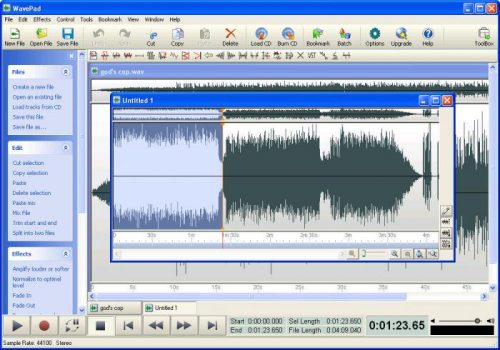WavePad is an interesting application which allows you to make multiple changes on your audio files. Using it, you will be able to copy, cut and modify an audio file as you want. The graphic representation of the sound makes easier your work. WavePad Master's Edition works with audio waveforms to make selections for quick editing, such as inserting sound from other files, or apply sound effects like the high pass filter to clarify audio quality. This free sound editor is ideal for anyone who needs to make recordings and edit on the go.
You want easy? I got easy.
 I’ve written a simple tutorial showing how to record audio using my favorite free audio editor, WavePad (no affiliate links here, btw).
I’ve written a simple tutorial showing how to record audio using my favorite free audio editor, WavePad (no affiliate links here, btw).You may have heard of Audacity, the well-known, open-source sound editor. Most people who create audio online use it and recommend it, but I’ve found it to be less than user-friendly. For one thing, you have to download and install a special file that allows you to convert your original .WAV recording to MP3, the format most used for listening to online audio. For a non-techie, that’s a barrier right there. After that, learning how to use Audacity is daunting for beginners.

That’s why I rave about WavePad, and urge you to try it instead. There’s no special file to install – MP3 conversion is built-in. You can choose from one of the pro versions that cost upwards of fifty bucks, but you don’t need all those bells and whistles to record your podcasts and interviews. The free version will do just fine. And it’s much easier to learn than Audacity.
So let’s give it a spin, shall we?
Recording Audio with WavePad
- First, download and install the free version of WavePad, then start the program. This is what it will look like (sort of – I have the Advanced version):
Click to enlarge
- Click “New File”in the upper left corner. Click OK to the box that pops up (no need for stereo.) Now you have an empty file, ready for recording:
- Click the red Record button in the lower left corner. A Record Control window will pop up:
Click to enlarge
- A. Leave this as Untitled.
- B. Check to make sure the Device listed is the microphone you are using.
- C. Make sure the Input has Master Volume selected.
- D. Adjust the volume with the Volume Control bar, if necessary.
- Make sure your microphone is on, click the Record button inside the Record Control window, and say a few words.
Notice the Recording Volume bar moving as you speak. Don’t worry if it peaks in the red zone, but keep it mostly in the green. (You can adjust this with the Volume Control bar (D):
- Click the square Stop button to see the visual depiction of your voice waves. Pretty cool, huh?
Click to enlarge
Note: See what I did here? It’s too loud. The Volume bar is all the way in the red, and some of my voice waves are jammed flat against the top and bottom of the window. It’s okay if a few of them hit the top and bottom, but not this many. If it’s too loud, your voice will sound distorted and icky.
Here’s what your voice waves should look like (note that the Volume bar is set to 0DB (zero decibels):
Don’t worry if the sound waves are smaller than you see here, even after you’ve set the volume as loud as it will go. I’ll show you how to adjust that in the next tutorial.
- Stop recording and close the Record Control window. Your recorded file will transfer to the Editing window – it’s magic!
- Save File As and give the file a name. Click OK.
- Now, Save File As again and Save As Type – choose .mp3. Click OK.
Et voila – done!
That wasn’t so bad, was it?
But if you just want someone to do it for you, I’m your woman!
Sign up here and I’ll get in touch.
Coming up in the next few posts, I’ll show you how to normalize the volume, record interviews on Skype, edit your sound files – and even add music.
See you soon!

Full featured audio editor for free
Older versions of WavePad Free Audio, Music and Mp3 Editor
It's not uncommon for the latest version of an app to cause problems when installed on older smartphones. Sometimes newer versions of apps may not work with your device due to system incompatibilities. Until the app developer has fixed the problem, try using an older version of the app. If you need a rollback of WavePad Free Audio, Music and Mp3 Editor, check out the app's version history on Uptodown. It includes all the file versions available to download off Uptodown for that app. Download rollbacks of WavePad Free Audio, Music and Mp3 Editor for Windows. Any version of WavePad Free Audio, Music and Mp3 Editor distributed on Uptodown is completely virus-free and free to download at no cost.Wavepad Audio Recording Software
See more